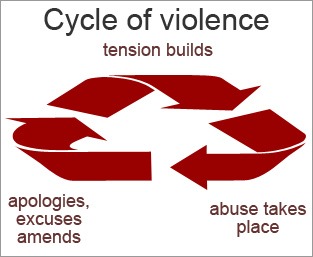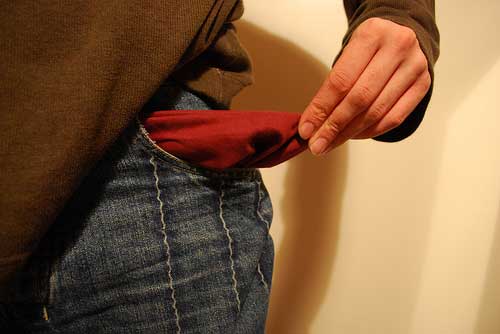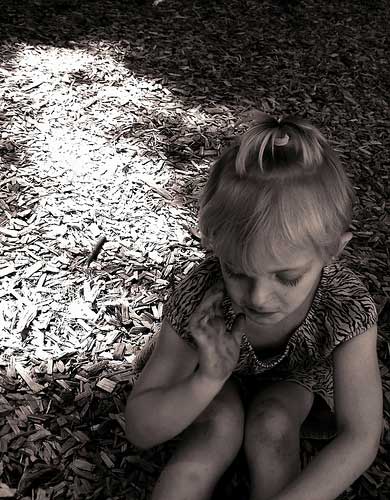Topics
Healing From Spousal and Child Abuse
“I often wonder why I carry all this guilt When it’s you that helped me put up all these walls I’ve built Shadows stir at night through a crack in the door The echo of a broken child screaming ‘please no more’ Daddy, don’t you understand the damage you have done To you it’s just a memory, but for me it still lives on.”
— Christina Aguilera song‚ “I’m OK.”

Christina Aguilera Speaks Out on Domestic Violence
For those of us who have lived with domestic violence abuse, Christina Aguilera’s words ring true: the pain lives on. In USA Weekendmagazine, Aguilera said‚ “My father was a sergeant in the Army, so we lived on Army bases when I was little, and it was happening a lot. The MPs would come, but a lot of them were doing the same things [to their wives and kids]. I was surrounded with domestic violence, not only in my home but my friends.” Christina saw her mother struggle, a battered spouse, against abuse and finally leave her husband when he began to abuse the children. As her songs indicate, she has chosen to speak out and help those who have been traumatized by domestic violence.
About Domestic Violence Abuse
- Are you being abused?
- The first step: LEAVE!
- Are you afraid to leave?
- Step Two: Take Care of Yourself
- Is your child being abused?
- The Next Generation of Violence
- Get Help
As have I. As I say in my book, Truth Heals, “Abuse of any kind is damaging, but even more so if inflicted by one’s own family or tribe because it shatters our basic sense of place and safety in the world.” In my case, the domestic violence abuse I experienced was sexual (which I talk about in more detail in Truth Heals and in and upcoming article on incest). “The fear and rage I felt from the abuse and my mother’s refusal to deal with it were kept underground. There was no speaking it, no feeling it, no acknowledging it in any way, at least not consciously.” And it was the burial of those feelings that led me as a teen and young adult into promiscuity, an eating disorder, bipolar behavior, drug and alcohol addition, and ill health, culminating in my mid-twenties with a major wake-up call: cancer and healing. I went through a lot on the road to recovery. First I got clean and sober through a 12-step program; I began a life-long habit of journaling (part of which became the basis for Truth Heals); I learned to meditate; and I wound up leaving the corporate world (where I was an attorney just like my father) and entering the world of healers, sages, and shamans to become who I am today: a teacher in the wellness field and an expert on abuse. Oh, and the cancer went into remission without the radical surgery that had been recommended as treatment.
Like all types of abuse, domestic violence cuts across every demographic–age, race, religion, socio-economic or education level, and gender. It is not solely a problem experienced among the poor, as some would believe. My abuser, my father, was a well-respected lawyer and politician in our community. My other abuser was a priest at my Catholic school who was my father’s confessor.

Domestic violence abuse is a huge widespread problem (it is also called Intimate Partner Violence — IPV — when it deals specifically with a couple in a relationship — whether that is marriage or dating, gay or straight.) The following domestic violence and spousal abuse statistics from the American Bar Association and the National Coalition Against Domestic Violence (download the NCADV PDF) are staggering:
- One in every four women will experience domestic violence abuse in her lifetime.
- An estimated 1.3 million women are victims of physical assault by an intimate partner each year. (85% of domestic violence victims are women.)
- 30-60% of perpetrators of intimate partner violence also abuse children in the household.
- Approximately one in five female high school students reports being physically and/or sexually abused by a dating partner.
- Fifty to eighty percent of teens report knowing someone involved in a violent relationship.
With numbers this big, you’d think that domestic violence abuse would be a huge story in the news at all times, but it took singer Chris Brown beating up his then – girlfriend Rihanna for the major news outlets to pay attention. Only when these two teen idols couldn‚’t hide what had happened from view — especially after TMZ.com (an entertainment news site) posted the picture of Rihanna and her bruised and battered face — was there any sort of public uproar about domestic violence.
That conversation has now been brought to the level of national government by President Obama, who in June 2009 created a new post: the first-ever White House senior adviser on violence against women. Lynn Rosenthal is an expert on domestic violence; in her new role she will help develop policies and programs that are meant to reduce the incidence of domestic violence, abuse and sexual assault. Vice President Biden, who as a senator wrote the Violence Against Women Act of 1994 (which he calledVAWA his “proudest legislative achievement”), said that Rosenthal would be “an integral part of this administration.”

Domestic violence needs all the attention it can get. It affects the victims over and over again, in both obvious and hidden ways. According to the National Women’s Law Center, in eight states, plus the District of Columbia, insurance companies treat being a domestic violence victim as a pre-existing condition. As far as insurers are concerned, if you’ve been beaten in the past or were the victim of spousal abuse, you’re likely to get beaten again and therefore you cost more to insure. They believe all victims will fall into the domestic violence cycle and battered women syndrome. So, domestic violence victims wind up being punished for the crimes of their abusers.
Are you being abused?
Domestic violence, abuse and sexual assault are about one thing only: control of the other person. According to a fact sheet put out by the CDC (Center for Disease Control), domestic violence includes four types of behavior:
- Physical abuse is when a person hurts or tries to hurt a partner by hitting, kicking, burning, or other physical force.
- Sexual abuse is forcing a partner to take part in a sex act when the partner does not consent. According to the National Coalition Against Domestic Violence, between one-third and one-half of battered women have been raped at least once during their abusive relationship. Those who are abused both physically and sexually are much more likely to be seriously injured or killed.
- Psychological abuse includes threats of physical or sexual abuse or the use of words, gestures, weapons, or other means to communicate the intent to cause harm.
- Emotional abuse is threatening a partner or his or her possessions or loved ones, or harming a partner’s sense of self-worth. Examples are stalking, name-calling, intimidation, or not letting a partner see friends and family.
An abuser uses any and every tactic to keep the domestic violence victim under his thumb. He or she may use fear, guilt, shame, intimidation, and may make good on threats to hurt you or those around you. Men are usually abused through verbal or emotional abuse, but women are far more likely to get physically hurt through partner and spousal abuse. An abuser feels like you are his possession, his property. You’ll do what he says, what he wants, or else! The most obvious sign of being in an abusive relationship is your own fear of your partner:
- Do you have to watch every word you say?
- Are you walking on eggshells whenever you’re together?
- Is he insanely jealous if you even look at another person?
- Does she yell at you, criticize you, and put down any attempt you make to better yourself?
- Are there certain topics you can never broach?
- Do you wonder if you’re crazy, or do you simply feel numb or helpless?
- Does she blame you for her behavior?
- Does he control the money, where you go, who you see, what you wear or eat?
There is a classic domestic violence cycle:

- Tension building phase. Stress starts to build over domestic issues (money, children, jobs) and verbal abuse starts. The victim tries to please or placate the abuser. When the tension boils over, physical abuse begins.
- Acute battering episode. This is commonly triggered by the abuser’s emotional state, not the victim’s behavior. It is unpredictable and not in the victim’s control.
- The honeymoon phase. The abuser feels shame about his behavior, is remorseful and apologizes, or tries to blame it on the victim. He insists that the abuse will never happen again, and convinces the victim not to leave.
This is sometimes called the battered wife syndrome or the battered girlfriend syndrome. But men can also be a battered spouse. For either sex, battering leaves bruises to the psyche that make the victim compliant or fearful enough to stick around for cycle after cycle of abuse — always with the hope that the last round of battering was the final one. According to prominent experts in the field, a person must experience at least two complete domestic violence cycles before being labeled a battered spouse. The psychological and behavioral symptoms of battered women syndrome are:
- The woman believes it was her fault that the violence happened.
- The woman is unable to blame the man for the violence.
- The woman feels her life and/or her children’s lives are in danger.
- The woman irrationally believes that her abuser is omnipresent and omniscient.
If this is a picture of your life, what should you do? Don’t fall into the battered wife syndrome, break the domestic violence cycle!
The first step: LEAVE!
“I represent an affluent district, but when I worked to form my county’s first battered-women’s shelter, some nights there were no beds left. Violence against women crosses all economic lines.” — Representative Lynn Woolsey of California
You cannot heal if you are still being hurt. You have to get out of the abusive situation. It is important to have support in place before you leave. If and when you make the decision to leave a violent relationship or spousal abuse, there are some basic steps you should take to protect yourself. These include:
- Locate contact numbers for domestic violence support services. They are out there, and you can find domestic violence support in your community or state. Ideally, you will have these before you leave.
- Line up a place to go that is secure. Be very careful who you notify about your location. Also, some experts recommend leaving a note for your abusive partner, saying that you are safe and that you will contact him when it feels safe to do so. This will reduce legitimate concern he has for your safety. But do not reveal where you are staying. The additional steps below are optional, depending on time and safety concerns.
- Gather legal documents for yourself and your children (birth certificates, social security cards).
- Have evidence of the abuse. Take photos of bruises or injuries. When abuse doesn’t leave marks, document it in a dated journal.
- Take care of your finances. Save money in a secure location. Get bank account numbers, mortgage papers, insurance cards, and other important documents. Because bank accounts may be jointly owned, it is essential to have money of your own.
I cannot emphasize enough that there are resources available to help you leave and restart your life. There are national, state, and local agencies that can help you with everything from getting medical care after an assault to going to court to helping with a down payment on a new apartment. They are there for you, and the feeling that you’re not alone is invaluable for those who have been isolated by abuse and fallen into the battered women syndrome. Seek out reputable sites like the following (and ones that may be available in your local area) and use them to regain some control and security in your life:
- National Coalition Against Domestic Violence – This non-profit organization provides crisis intervention, information, and referral to victims of domestic violence, perpetrators, friends and families. Visit NCADV.org.
- National Sexual Violence Resource Center – Visit NSVRC.org.
- Family Violence Prevention Fund – Visit EndAbuselb.org.
Are you afraid to leave?
“I’ve never disclosed who it was, but that guy hit me that one time and that was the last time. It [the relationship] was done the minute he did that. The one thing my mother always told me, `If a man hits you, you leave smoke. You get to gettin’.’ So I got my stuff and got goin’.” — Halle Berry
Many people outside of abusive relationships wonder why the victims (mostly women, which perpetuates the battered wife syndrome) do not simply leave like Halle Berry did. Domestic violence engenders far more ambivalence towards domestic violence victims than do most other violent crimes. We want to believe that the victims provoked the assault so that there is a “reason” for the battering, like many of Chris Brown’s young fans thought about Rihanna. Or we think that somehow the victim should have been smart enough to get away or strong enough to call the police.

Those who have never experienced violence at home are probably thinking‚ “If that was me, I’d be out of there in a flash.” They are sure they would leave with no money, with nowhere to go. But domestic violence abuse is never simple, and it is often tremendously difficult to leave. The feeling of worthlessness and guilt are hard to explain to those who have never been on the receiving end of a slap or punch or harsh and threatening words. Does that mean the victims are “asking for it” or that they deserve it in some way? Absolutely not.
Are you a victim who is afraid to leave?
Maybe you don’t expect anything better from life. Maybe you’ve been made to feel like you did do something to provoke the abuse, that if you could just be a little better, a little more willing to comply with all their demands, then you wouldn’t be hit. Even if in some part of yourself you know this is not true, being a domestic violence victim makes you doubt yourself. Your sense of “self” has been shattered, your psyche damaged by the need to be on guard at all times, your sense of security and safety nullified (if it ever existed at all). Maybe your abuser controls the family finances, has taken your savings or created a huge load of debt, or has in some way prevented you from completing your education or ruined your employment record or opportunities. How will you support yourself and your kids?
Typically, battered women stay with their abuser because:
- They fear escalated levels of violence if they leave. Sadly, restraining orders do not always prevent attacks.
- They may believe the abuser is capable of seriously harming them or their children or other family members.
- They may not know where to go or where to get help. And there are too few shelters to accommodate battered women when they do leave.
- Many abused women do not work outside the home and have at least one child. They may not think they can survive economically.
- Many fear having joint custody with the abuser. What would happen if they weren’t present to protect the children?
- They may be urged by family or religious beliefs to stay in their marriages.
- Some believe a bad father is better than no father.
- Many women feel isolated and ashamed of their situation. Asking for help or leaving would mean revealing their secret of spousal abuse.
- There are usually periods of normalcy and calm (the‚ “honeymoon” phase of the domestic violence cycle) that lead women to hope the abuse is over.
What about women who are the main breadwinner in the family?
I had a client named Sarah who was struggling with issues arising from domestic violence she had witnessed as a child. She was far angrier with her mother than with her abusive father because her mother stayed in the relationship. The mother was educated and was the sole earner in the family, so she could have raised Sarah without‚ “help” from Sarah’s father. Instead, she endured the abuse, and Sarah endured it as well. Sarah wanted to know why her mother stayed.
Through our work together, Sarah eventually understood that her mother was very religious and didn’t view divorce as a viable option. She would have been ostracized by her family, leaving her with nowhere to go and very little support. She had been raised to accept her lot in life and make the best of it. She believed that having a father was crucial to her child’s upbringing and having a “whole” family was necessary. We can never judge someone else’s decisions. For years, I couldn’t fathom why my mother allowed my father to stay in the same house with us when she had to know what he was doing to me. Like Sarah, I was far more outraged with what I perceived as my mother’s indifference to than with my father’s spousal abuse. Healing from an abusive childhood requires understanding and forgiveness of all who were involved, as well as doing everything possible to take care of yourself.
Step Two: Take Care of Yourself
“You yourself as much as anybody in the entire universe deserve your love and affection.”— Buddha
Victims of domestic violence abuse can recover and heal. Consider Tina Turner. She survived years of abuse at the hands of her husband, Ike, but despite the fact that she left with 86 cents in her pocket and all the financial hardships that ensued, she managed to get away. Tina says that she developed the necessary strength to leave after she was introduced to a daily Buddhist practice that centers on chanting a mantra that reaches the‚ “god within” and helps people attain a greater level of spiritual clarity. Tina Turner was not only a domestic abuse survivor, she came into her own and thrived. Healing from abuse is often started and restarted many times over. Most women try to leave (or leave and come back) seven times before leaving for good. But escaping abuse is only the first step — the start of recovering your physical, spiritual, and emotional health. Here are some ways that you can restore balance and happiness to your life after you’ve experienced domestic violence abuse:
Domestic Violence Counseling
I strongly urge you to go to counseling. If you have children who witnessed the abuse or were themselves targets of violence, get them counseling as soon as you can. Take advantage of community or state resources for domestic violence victims and/or join a support group (online communities can also provide much-needed support).
Domestic Violence Journaling
Releasing emotional pain requires us to talk about it. Again and again and again, if necessary. It is often easier to write about it, whether as a first step in preparation for talking about it or as a way to release pain in and of itself. Journaling is immeasurably helpful in dealing with trauma. Numerous studies demonstrate that anxiety and stress are greatly reduced through journaling. For those of you who want to journal, here’s how to get started. Before you turn out the light tonight, take just 5 or 10 minutes, or as much time as you need, and really write how you feel about one thing that you’re worried about in the present or some part of your past that comes up in consciousness. This isn’t the time to censor or edit or, god forbid, spell check. The key is to write a stream of consciousness until you feel like you’ve “said it all” on that one subject. Some people like to go back and read what they’ve written, but that’s not necessary. The real benefit of journaling comes with the act of writing, and it doesn’t matter if you use pen and paper or a laptop. You’ll soon discover that when you write, you will access a deeper part of yourself and process a deeper part of your emotions. For those who don’t know where to start, get a guided journal specifically designed for victims of trauma and/or emotional upheaval. Write, write, write.
Exercise

I don’t care what condition you have or what you have struggled with, there is some form of exercise for everybody. The benefits to the body are long established and the benefits to the mind are even more powerful. Reduce depression, anxiety, illness, regain energy and confidence. Walk, bike, dance, hike, swim, take classes at the Y, play soccer in your community league: do something you enjoy and do it as often as you can. Yoga is one beneficial exercise that has been shown to help in dealing with trauma. The Trauma Center at the Justice Resource Institute www.traumacenter.org routinely uses yoga to help patients heal from Post Traumatic Stress Disorder (which many domestic violence victims have — I certainly did). One study reported that women who completed eight (hatha) yoga classes showed significant improvement in symptoms, including anxiety and intrusive thoughts. According to one woman in this study, who was the victim of spousal abuse:
I’ve realized that I’m a very strong person. [Yoga] reminds me that if I just keep plodding along, I can get there. I can face it in little chunks and say‚`I can work with this piece.`
Meditation
Besides getting clean and sober, meditation is the single most important thing I’ve ever done for myself. Meditation makes you feel really present, totally relaxes your body and mind, takes away your stress, and makes you look and feel younger! Most of us have way too much on our minds to be expected to just sit and meditate without some help. So do what I did: find a class and learn from a teacher. My teacher taught me how to get to that space beyond my thoughts where I could finally experience real peace and joy.
Is your child being abused?
“Child abuse casts a shadow the length of a lifetime.” — Herbert Ward
Often, abusive parents/caregivers insist that they are just disciplining an unruly child to get that child to behave. But a quick swat on the backside is not the same as striking a child with hand, fist, or foot, or with an object, or shaking, burning, pushing or throwing a child, pulling a child by the hair, or choking a child. If the person who is abusing you is acting that way with your child, your child is being abused as well, not simply being punished or disciplined. Children who are being abused learn to be prepared for anything and are hyper-vigilant. They often feel guilty and somehow responsible for the domestic violence, abuse or sexual assault. If you are worried about a child, see if they exhibit any warning signs of physical abuse:
- Physical abuse — unexplained bruises, welts, or cuts, age-inappropriate injuries, injuries that are patterned (such as marks from a hand or belt), or a pattern of severe injuries.
- Behavioral abuse — fearful, shying away from touch, afraid to go home, wearing clothing that is inappropriate for the weather (such as concealing arms and legs even on hot days).

A mother might be trying to protect her children from intimate partner violence (IPV), but may not realize that the children are being emotionally abused even if they are not being beaten. Signs of emotional abuse include: excessive shyness, general fear and anxiety, fear of doing something wrong, a child trying to parent other children or antisocial or aggressive behavior, infantile or regressive behavior.
Children who live with domestic violence abuse have to live a double life. Most often, they put on a facade at school or with friends, always hiding what is going on at home. This leads to a host of problems and distorts their world view. As they age, problems down the line include substance abuse, anxiety, and a skewed perception of what relationships should be like.
We can see this very clearly when we examine the life and death of Michael Jackson. His claims to have been abused by his father as a child certainly are borne out by his physical and emotional health later in life. Various sources have said that Michael was pushed, threatened, intimidated, verbally abused, and beaten by his father. Michael became extremely anxious and would become physically ill when he had to be near his father. As an adult, he exhibited extreme self-loathing, as evidenced by his addiction to plastic surgery, which rendered him virtually unrecognizable from his former self. Those who have been abused frequently feel immense guilt and low self-worth, which he certainly did. He became addicted to painkillers, which is not uncommon for domestic abuse survivors. He was also continually trying to regain a sense of the childhood — trying to live in Neverland — that he had been denied.
Jackson’s health also suffered. We saw pictures of him in recent years in which he was in a wheelchair. According to several reports, Michael had an autoimmune disease known as vitiligo, which kills skin pigmentation. He may have also suffered from another autoimmune disease, lupus, which often accompanies vitiligo. All of these issues, emotional and physical, are related directly to imbalance caused by his childhood exposure to domestic violence and abuse.
Or look at Marilyn Monroe, who started life as Norma Jean Baker. She was born to a mother who suffered from paranoid schizophrenia. Marilyn was severely neglected and shuttled off to eleven foster homes and one orphanage as a child. When she was eight, a friend of her foster family sexually assaulted her. Moreover, her marriage to baseball great Joe DiMaggio is said to have been violent and filled with spousal abuse. He was extremely jealous and hated when others paid any attention to her. He reportedly broke her finger after she agreed to perform for troops in Korea and beat her after the filming of her famous scene in The Seven Year Itch, in which her flowing white skirt is blown up by the street grate. Despite her success in film and her enduring legacy as a sex symbol, Marilyn never achieved what she really wanted: happiness. She said of her childhood:
The world around me then was kind of grim. I had to learn to pretend in order to… I don’t know… block the grimness. The whole world seemed sort of closed to me… I felt on the outside of everything and all I could do was to dream up any kind of pretend game.
To the children affected by domestic violence, abuse makes their lives not a fun fantasy, but a day-to-day attempt to survive. Unfortunately, the scars they carry can impact the next generation as well.
The next generation of violence
“I just want you to know that I love you. But I’m gonna take a baseball bat one day while you at work, and I’m gonna kill him.”
This is what an eleven-year-old Chris Brown told his mother one day, referring to the hatred he felt towards his stepfather, Donnelle Hawkins, who lost his sight after a failed suicide attempt. Chris toldGiant magazine:
When you’re blind, your senses are heightened, like your smell, hearing, your sense of touch. You can move and maneuver around your sight. But he used to hit my mom… He made me terrified all the time, terrified like I had to pee on myself. I remember one night he made her nose bleed. I was crying and thinking, ‘I’m just gonna go crazy on him one day…’ I hate him to this day.
Those who grow up with domestic violence may seek out abusive relationships or fall into the battered women syndrome when they are older. Boys, in particular, who witness domestic violence are twice as likely to abuse their own partners and children when they become adults.
This certainly seems to have been the case with Chris Brown, although Donnelle Hawkins denies any abuse. On the “Tyra Banks Show” Brown related that his mother was a domestic violence victim from the time he was 7 until he was 13 years old. He said, “I treat [women] differently because I know I never want to go through the same thing or put a woman through the same thing that the person put my mom through.” But when his emotional balance was pushed to his limit, he repeated the domestic violence cycle he had witnessed, even though he had hated it.
But the violence doesn’t have to be repeated. Dr. Steven Stosny was a victim of domestic violence abuse as a child and has turned his attention to the abusers. He heads a in Maryland for batterers, and his program has double the success rates of traditional programs. Why?
Our program is based on the idea that most batterers can’t sustain attachment, and because of this, they become flooded with feelings of guilt, shame, and abandonment, which they regulate with aggression… Our clients learn that blame is powerless, but compassion is true power, and has the ability to heal. Next, you explain to yourself the core hurt that anger is masking: feeling unimportant, disregarded. guilty, devalued, rejected, powerless, and unlovable. All abusive behavior is motivated by these core hurts.
According to Dr. Stosny, abusers lash out because they are reminded of how unloved and worthless they feel (remember, this is not the fault of the domestic violence victims in any way). The abuse actually continues this domestic violence cycle and perpetuates these feelings.
Does this lessen their culpability? Not at all. It is always wrong to abuse. Always. But it does no good to fail to recognize the scars of the abusers, which need to be healed so the family can heal or so the abuser does not continue the domestic violence cycle in new relationships.
As with everything, healing from domestic violence, abuse and sexual assault comes down to truth. When we recognize and honor our truth and release the negativity and pain we have lived through and the parts we have buried, then we begin the process of healing our physical and emotional wounds. When you realize that you don’t have to live your life defined by domestic violence, you open your heart and mind to true, lasting healing. Truth heals, and in the journey to recovery from the ravages of domestic violence, truth is our strongest ally.
Get Help
If you are a victim of domestic or intimate partner abuse, or know someone who is experiencing spousal abuse or is a battered girlfriend or significant other, there is help available. Be careful. Your abuser could be reading whatever you post or email online. Please use a safe computer (at the library, at an Internet cafe) and/or call the following to break free from the domestic violence cycle:
- THE NATIONAL DOMESTIC VIOLENCE HOTLINE at 1-800-799-SAFE(7233)
- THE NATIONAL SEXUAL ASSAULT HOTLINE AT 1-800-656-4673
- THE NATIONAL TEEN DATING ABUSE HOTLINE AT 1-866-331-9474
If you suspect a child is in immediate danger of domestic violence and abuse, contact law enforcement as soon as possible. Call: 1-800-4-A-CHILD (1-800-422-4453) — Childhelp National Child Abuse Hotline To get help for child sexual abuse, call: 1-888-PREVENT (1-888-773-8368) — Stop It Now– 1-800-656-HOPE Rape, Abuse & Incest National Network (RAINN)
